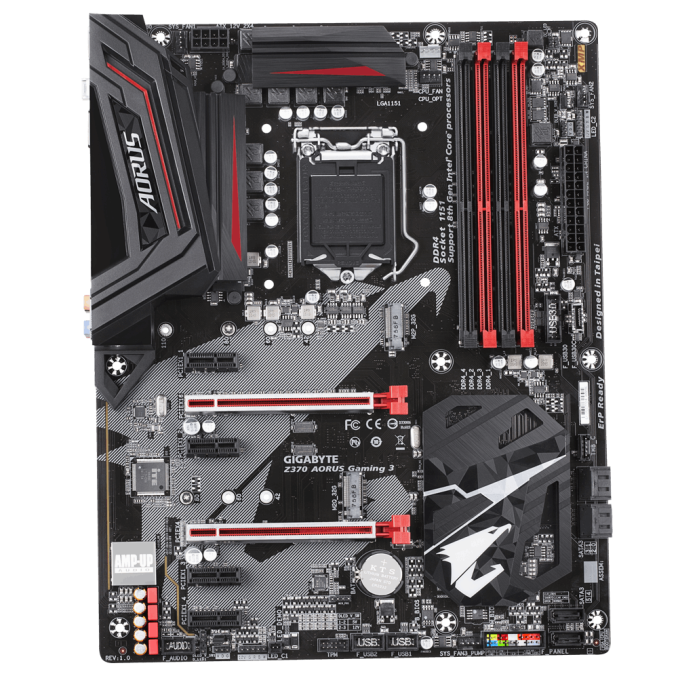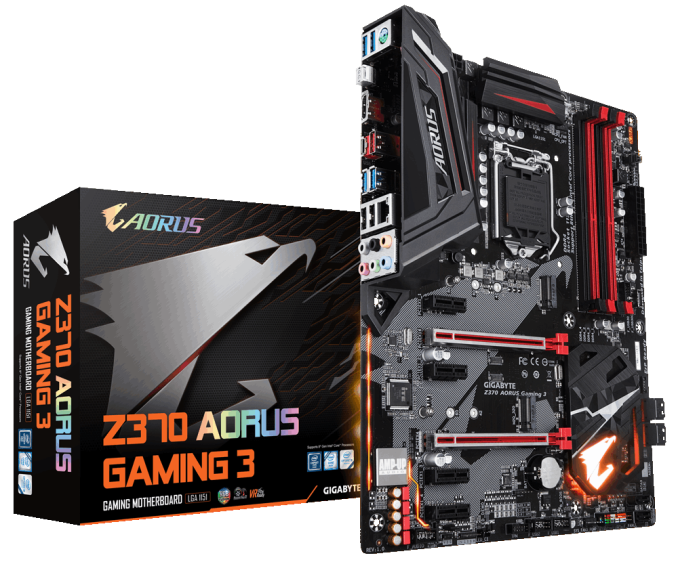Analyzing Z370 for Intel's 8th Generation Coffee Lake: A Quick Look at 50+ Motherboards
by Ian Cutress, Anton Shilov, Joe Shields & Gavin Bonshor on October 20, 2017 2:00 PM ESTGIGABYTE Z370 Gaming 3
The next board is the Z370 AORUS Gaming 3. This board purports to be on the middle of their Gaming series of motherboards and includes RGB Fusion, dual M.2 slots, a Killer E2500 Gaming LAN, the Ultra Durable feature set, and a different color scheme than the other boards in the gaming line.
The Z370 AORUS Gaming 3 uses a black PCB with the AORUS falcon stenciled in through the PCIe area. What is different here compared to some of the other gaming boards is that the reinforced PCIe slots are red instead of black. Instead of all black DIMM slots, two on this board are red; a departure from all black we have seen on the Gaming line previously. The DIMM slots on the Gaming 3 also do not have the strengthened slots. It uses the same chipset heatsink as the Ultra Gaming, and the heatsink is one of two places users will find RGB LEDs on the board. The other location is the audio separation line.
The Gaming 3 uses the platform standard four DIMM slots with speeds up to DDR4-4000 and capacity up to 64GB. The PCIe layout is different on this board compared to what we have looked at previously from GIGABYTE: on this board, there are only two full-length PCIe slots and four PCIe 1x slots. The full-length slots are reinforced (part of their ultra-durable features) and run in an x16/x4 configuration allowing AMD 2-Way Crossfire but not SLI as NVIDIA requires an x8 speed on the slot. That PCIe 3.0 x4 is powered by the chipset, similar to the Z370-P.
For SATA storage, there are six SATA ports, four of which are located on the right side of the board by the PCH, while the other two are found a towards the bottom right-hand corner in a vertical orientation. The two M.2 slots are located just above the top PCIe 1x slot and just above the second full-length PCIe slot. The top slot supports 110mm drives, while the bottom supports up to 80mm.
There are a total of five fan headers on the board. with the CPU and water cooling CPU fan headers by the socket, a system fan by the 8-pin EPS plug, a system fan to the right of the DIMM slots, and the last header is at the bottom of the board. If the lack of RGB LEDs on the board is a turn-off, there are RGBW headers found on the board (one across the bottom, the other by the 24-Pin ATX power connector). Onboard audio is handled by the EMI shielded Realtek ALC1220 codec and like most other gaming boards, uses the Nichicon and WIMA caps. The NIC of choice on this board is the Rivet Networks Killer E2500 and is the only network controller on the board. The Gaming 3 does not include WiFi. Thunderbolt 3 is supported on this board via AIC (Add-In Card).
USB 3.1 (10 Gbps) is handled by an ASMedia 3142 controller and gives us one Type-A and one Type-C adapter both found on the back panel I/O area. From the chipset is another Type-C internal header (5 Gbps), four USB 3.1 (5 Gbps) four ports on the back panel and two more through internal USB headers. There are two USB 2.0 ports on the back panel, and four more through internal USB headers. The remainder of the back panel I/O connectivity consists of a combo PS/2 port, a one-touch overclocking button, an HDMI output for using onboard video, and the audio stack (no SPDIF).
The Gaming 3 finds itself squarely in the middle of the GIGABYTE stack. The mix of features, such as the Killer Gaming NIC, an upgraded audio section, and reinforced slots keep gaming a priority on this board. However, the lack of SLI support will send those with multiple NVIDIA GPUs looking elsewhere.













83 Comments
View All Comments
sor - Friday, October 20, 2017 - link
Damn. At least key it differently and call it LGA1151v2 or something.The changes are so minimal it really does seem like planned obsolescence. Does it really need more power pins to support new chips with the same power envelopes? Really? They couldn’t handle that on the CPU PCB?
KaarlisK - Saturday, October 21, 2017 - link
Actually it is ~1.5 times peak current with the same average power envelope, so yes, they need the change.If they had not brought the launch forward and just launched together with the cheap chipsets, there would be far less complaints.
sor - Saturday, October 21, 2017 - link
Where did you find information indicating current has increased 50%? I just spent about ten minutes trying to find a reference backing that up, perhaps something indicating the 8 series operates at a much lower voltage within same TDP, which would translate to higher current but they seem to operate in the same 1.2-1.3v range.You’re not just assuming they draw more current because they have two more cores, are you?
KaarlisK - Sunday, October 22, 2017 - link
Notice the difference between average and peak.And the information is in publicly available documents. I did not bother to look it up, but others have, for example: https://forum.beyond3d.com/threads/intel-coffee-la...
Crono - Saturday, October 21, 2017 - link
Nice roundup. That's a lot of motherboards to spec and summarize. I especially appreciate the handy chart at the end, it's a good, quick-and-dirty comparison tool.Landcross - Saturday, October 21, 2017 - link
You guys forgot 2 new Z370 boards from Supermicro :)https://motherboarddb.com/motherboards/?chipset=19...
Xpl1c1t - Sunday, October 22, 2017 - link
The mITX board looks incredible.+ Low ESR Tantalum capacitors! (first time seeing them on VRM duty on a mainboard)
+ HDMI 2.0
+ 2x M.2 Slots
+ USB 3.1 Type C
+ Optical SPDIF
- RGB.......
MadAd - Saturday, October 21, 2017 - link
Great write up but for me its just another depressing generation of oversized, overpriced ATX form factor offerings on which the vast majority of users wont even plug a second gpu into, with the smaller and more size appropriate FF represented as a minority afterthought.With all the progress of PCs since the 90s whod have thought that I could still use the same ATX case today while every single other component (from floppy drives to 2d Mattrox cards) have long gone to the recyclers. I find it so annoying how manufacturers have stuck on this prehistoric gargantuan case size with the other sizes being an afterthought. It feels like like stifled innovation while everything else is moving on.
rocky12345 - Saturday, October 21, 2017 - link
Great article and a lot of work put in to get it out for us to read thank you.My only issue is and it is nit your fault is why these companies feel the need to totally blanket the market with basically the same boards just a different model number and basically a few tiny changes and spray paint it a different color and use the word gaming and put something x or x1 or k,k3 etc etc. For crap sakes just release three models not 7-10 models of the same crap it is pretty much just greed I guess.
The whole market is like this now with anything computer related of and if it has the words GAMING or RGB in it's got to be good for sure. My fav is that gaming mouse pad next it will have RGB lighting in it...lol
CitizenZer0 - Wednesday, October 25, 2017 - link
Agreed